Stretching over 2,500 kilometres, the Mighty Murray River weaves through three Australian states. It plays a vital role in the history and development of inland towns. Along its banks, an intriguing network of Span Lift Bridges stands as a testament to the ingenuity and resilience of earlier generations.
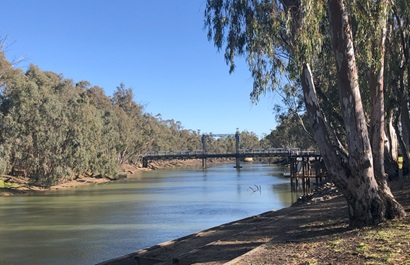
These engineering marvels were designed to carry trains and vehicles across the river and raise to allow paddle steamers and trading boats to pass freely below. Each bridge tells a story of river trade, regional growth, and clever design, making them fascinating landmarks for anyone journeying through Australia’s heartland.
History Of Span Lift Bridges On The Murray
In the late 1800s and early 1900s, as riverboat trade flourished and railway lines expanded inland, the need for dual-purpose bridges became clear. The Murray was a busy highway for paddle steamers carrying wool, wheat, and supplies. While towns on either side of the river demanded reliable road and rail links.

The solution came in the form of span lift bridges. Structures with a central section that could be raised to let tall vessels pass beneath. Designed by some of Australia’s leading engineers of the time, including Percy Allan, these bridges were triumphs of early civil engineering. Today, they remain as proud relics of a time when rivers were lifelines and innovation was driven by necessity.
How Lift Span Bridges Work
Lift span bridges feature a central section that can be mechanically raised to allow tall river traffic to pass. Using pulleys, counterweights, and heavy-duty lifting gear, the bridge’s movable span is lifted straight up between two towers.
This clever design allowed riverboats to pass through without stopping road or rail traffic for too long. While many of the bridges along the Murray no longer lift due to changes in river use. Several are still operational, or at least preserved in working condition. They continue to amaze visitors with their robust design and graceful movement.
Span Lift Bridges Located Along The Murray River
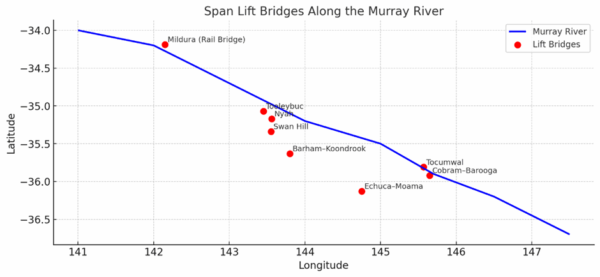
Here is a map showing the Murray River’s approximate path, along with the locations of key span lift bridges marked in red. Each bridge is labelled with its name, offering a visual guide for your travel blog or itinerary planning.
Notable Span Lift Bridges Along The Murray River
Let’s take a look at some of the most iconic lift span bridges that cross the Murray River:
Cobram–Barooga Bridge
Opened in 1902, the Cobram–Barooga bridge was another Percy Allan design and once featured a lift span to accommodate river traffic. Though the lifting mechanism is no longer in use. The bridge retains its heritage charm and serves as an important crossing between Victoria and New South Wales.
Echuca–Moama Bridge (Old Bridge)
Completed in 1878, this historic iron and timber bridge once served both rail and road traffic. It features a central lift span that enables paddle steamers to pass. While it’s no longer in operation as a lift bridge, it’s now used as a pedestrian and cycling path. This offers wonderful views of the river and the Port of Echuca.
Tocumwal Bridge
This unique bridge was built in 1895 and features a combined road and rail design. Its central lift span allowed paddle steamers to pass under, while trains and vehicles moved across. While rail operations have ceased and the lift mechanism is no longer active, the Tocumwal Bridge remains a local icon.
Barham–Koondrook Bridge
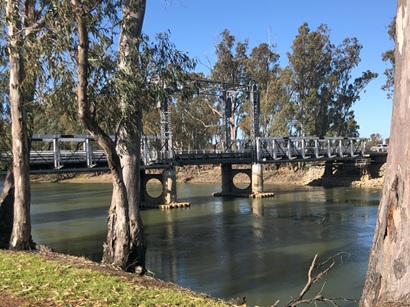
Sir John Monash was the Head Engineer during the building of the Koondrook Barham lifting bridge. Opened in 1904, the Barham–Koondrook bridge is one of the best examples of a functioning lift span bridge on the Murray.
Still in use for road traffic and is maintained as a heritage structure. Its central section is occasionally raised, and the control tower adds character to the river crossing. It’s a favourite photo stop for visitors and a proud symbol of both towns.
Swan Hill Span Lift Bridge
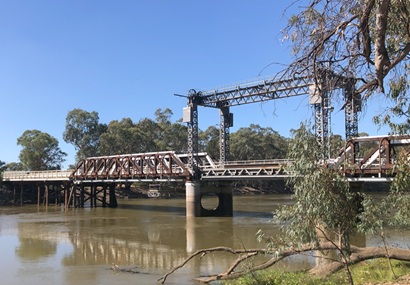
Built between 1896 and 1900, this bridge is still in use today and is one of the few that retains its working lift span. Designed by Percy Allan, it’s a perfect blend of beauty and practicality. While the lift section is rarely raised today. It stands as a functioning structure and a link to Swan Hill’s riverboat heritage.
Nyah Span Lift Bridge
Tooleybuc Lift Bridge

The Tooleybuc Lift-span Bridge, completed in December 1924 and opened in February 1925, is a heritage-listed Allan timber truss bridge spanning the Murray River between New South Wales and Victoria.
Designed by noted engineer Percy Allan, it was the final lift-span truss bridge he created and is one of just two surviving examples on the Murray River.
With a single-lane roadway and three main spans, including a central 17.8 m steel lift span, supported on concrete piers. The bridge was built to replace a punt used to carry cars and other modes of transport across the Murray River. It also needed to keep paddle steamers moving by lifting the central span as needed.
It remains operational and carries local traffic on the Mallee Highway, including trucks. Fully listed on both the NSW and Victorian heritage registers, the bridge is appreciated for its technical ingenuity and picturesque setting. It provides a charming gateway between states and a reminder of early 20th‑century road and river transport.
Mildura Rail Bridge
Constructed in 1927, the Mildura rail bridge included a lift span to cater to the busy paddle steamer trade. Although trains no longer cross it and the lifting gear is no longer operational, the bridge remains part of Mildura’s historic riverfront and can be seen from the walking tracks nearby.
Span Lift Bridges In South Australia Along The Murray River
Paringa Lift Bridge
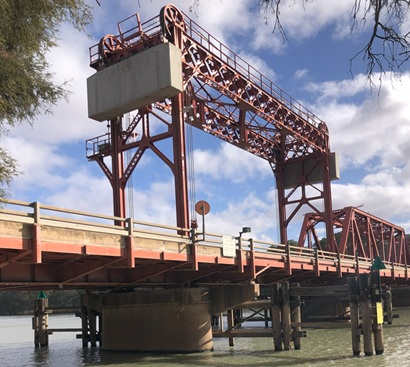
The Paringa Bridge is a striking steel vertical-lift span bridge that has connected Paringa and Renmark across the Murray River since its opening on 31 January 1927. Designed by South Australian Railways and fabricated by Perry Engineering in Adelaide, it was built to carry both the Barmera railway and the Sturt Highway in a combined configuration.
The bridge spans approximately 173 m, with three 34.3 m Pratt-truss spans, plate-girder end spans, and a central lift span measuring 24 m, which can rise 9.1 m in about 90 seconds to allow passage of houseboats and paddle steamers.
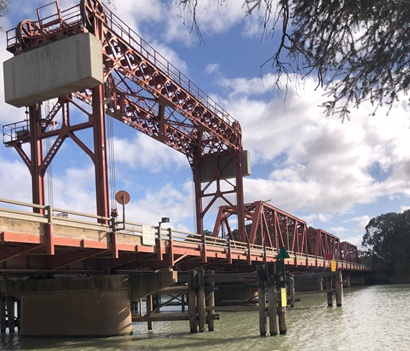
While rail traffic ceased in 1982 and tracks were removed in 1986. The former rail reserve now serves as a shared pedestrian and cycle path.
Today, the bridge remains an essential part of the Sturt Highway, capable of accommodating heavy B‑double trucks. It retains its lift operations, typically scheduled at 9:30 am and 2:30 pm, for river traffic.
Heritage-listed for its engineering significance, it stands as one of only two lift‑span bridges in South Australia and continues to fascinate visitors with its blend of historical function and scenic charm.
The only other lift-span bridge in South Australia besides the Paringa Bridge is the Murray Bridge Railway Bridge, originally known as the Murray River Bridge. It was constructed in 1879 as a combined road and rail bridge, but the lift-span section was added later in 1925 to allow for river traffic during high water or paddle steamer passage.
Key Points:
- Location: Murray Bridge, SA
- Function: Originally combined road-rail, now rail only
- Lift Span: Rarely used today, but still part of the structure
- Heritage: Both Paringa and Murray Bridge Railway bridges are listed for their engineering and historical significance.
These two bridges—the Paringa Bridge (1927) and the Murray Bridge Railway Bridge (lift added 1925)—are the only two vertical-lift span bridges in South Australia.
Heritage And Preservation
Many of these lift span bridges are now heritage-listed, recognised for their engineering significance and contribution to regional development. They represent a period when infrastructure had to accommodate both modern progress and natural waterways. Local councils and historical societies work hard to maintain these bridges and share their stories, ensuring future generations appreciate the ingenuity behind them.
Exploring The Bridges Today
For travellers, these bridges offer more than just crossings—they’re destinations in their own right. Consider planning a road trip along the Murray, stopping at towns like Echuca, Barham, Swan Hill, and Tocumwal to admire the bridges, take photos, and soak up the history. Many of the bridges are within walking distance of cafes, visitor centres, and scenic river walks. Caravan parks and heritage precincts make it easy to turn your visit into a relaxed few days of discovery.
Fun Facts And Trivia
- The oldest lift span bridge on the Murray is the Echuca–Moama bridge, built in 1878.
- The Barham–Koondrook bridge still lifts occasionally—usually for heritage events or maintenance.
- Percy Allan, the designer of many Murray bridges, also developed the iconic Allan Truss used widely across NSW.
- At one time, bridge keepers lived in houses near the bridge and manually operated the lift span.
Span Lift Bridges In Conclusion
The span lift bridges of the Murray River are more than just impressive feats of engineering—they are windows into the past and markers of the river’s importance in shaping inland Australia. Whether you’re a history lover, a fan of old bridges, or simply enjoy discovering quirky local features, visiting these structures offers a unique and rewarding experience. So next time you’re travelling along the Murray, stop for a moment at one of these majestic old bridges—and imagine the paddle steamers gliding underneath as they once did.
